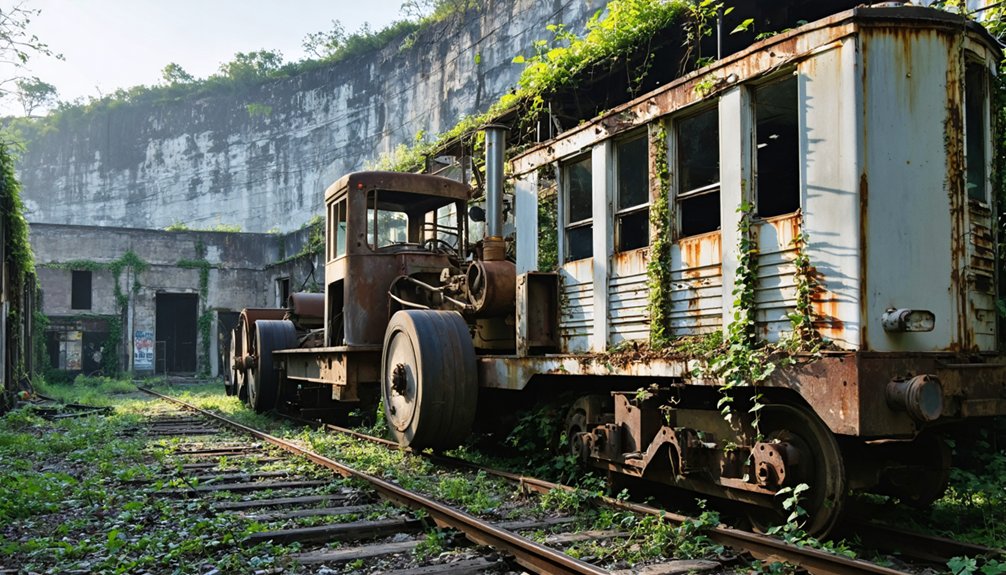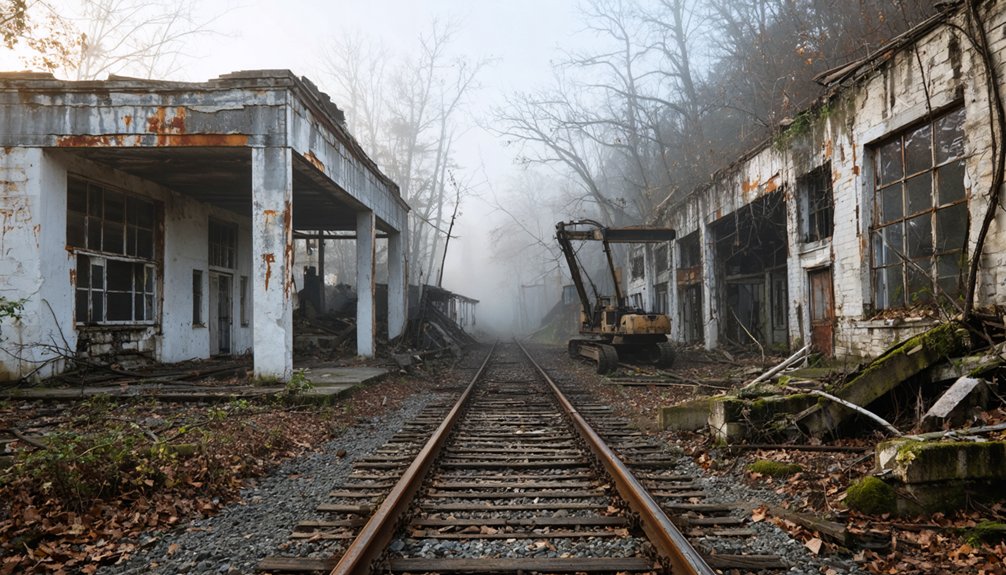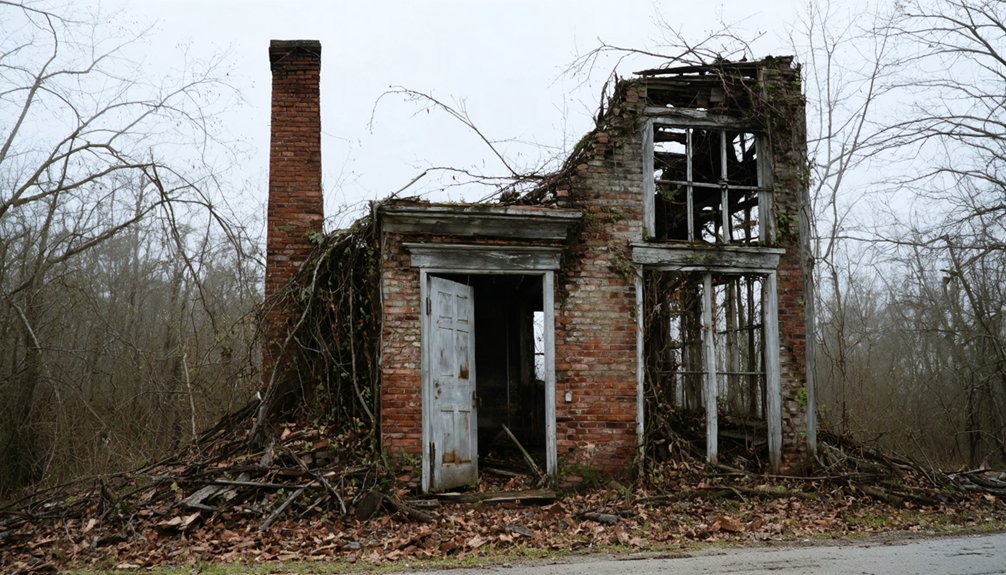You’ll find Gantts Quarry‘s ghost town remnants in Alabama’s Murphy Marble Belt, where Dr. Edward Gantt first discovered high-quality marble in 1813. The town flourished as a marble mining community, peaking at 542 residents in 1930 under the Alabama Marble Company‘s management. After contributing stone to national landmarks like the Washington Monument and Lincoln Memorial, the town faced steep decline, dropping to just 7 residents by 1990 before complete abandonment in 2000. The story behind its white marble roads and abandoned quarry tells a deeper tale of American industrial rise and fall.
Key Takeaways
- Gantts Quarry transformed from a thriving marble mining town into a ghost town, officially disincorporating in 2001 with zero residents.
- The town’s population peaked at 542 in 1930 before declining drastically to just 7 residents by 1990.
- As a company town, residents lived in company-owned housing until the structures were demolished in the late 1960s.
- Economic decline, particularly after the Great Depression, caused residents to migrate to larger industrial centers like Birmingham.
- Today, only abandoned buildings, mining roads, and the relocated post office remain as evidence of the former marble mining community.
The Discovery of Marble and Town Origins
While exploring the region during the Creek War of 1813-1814, Dr. Edward Gantt made a remarkable marble discovery that would shape Alabama’s future.
You’ll find this massive deposit, known as the Murphy Marble Belt, stretching 32 miles long, 1.5 miles wide, and 400 feet deep – one of the world’s largest calcium carbonate deposits.
Gantt didn’t waste time after his discovery. By 1830, he’d purchased the land and started quarrying operations within a decade.
The town’s origins trace directly to his ambitious efforts, though early progress was challenging. You’ll appreciate the determination it took to transport marble slabs nine miles by ox team to the Coosa River.
Despite having to pause operations in the 1850s due to lacking railroad infrastructure, Gantt’s legacy lives on in the Washington Monument, where two Alabama marble blocks stand as evidence of his discovery.
The quarry site eventually became the center of marble-working by 1906, establishing its industrial importance.
The town later achieved municipality status in 1910 to prevent being annexed by the nearby city of Sylacauga.
Rise of the Marble Industry
After decades of modest operations, Gantts Quarry transformed into a major industrial center when New York investors acquired the site in 1906.
The Alabama Marble & Stone Co. revolutionized marble extraction by introducing modern equipment and establishing vital rail connections that opened national markets.
You’ll find the quarry’s rise was perfectly timed with America’s neoclassical architectural revival. The marble’s quality rivaled famous deposits in Italy and Greece, leading sculptors and architects to incorporate it into banks, memorials, and public buildings across the country. Italian sculptor Giuseppe Moretti helped establish the marble’s reputation in the early 1900s.
The development of carborundum grinding techniques in the early 1900s significantly enhanced the precision of marble processing at the quarry.
By 1959, production soared to 100,000 tons of ornamental marble yearly, with another 200,000 tons of crushed stone.
The industrial growth spawned a bustling company town complete with worker housing, schools, and community facilities – all centered around the promise of white marble.
Life in a Company Town
Despite being governed by its own mayor and city council, Gantts Quarry remained firmly under the Alabama Marble Company‘s influence, which shaped nearly every aspect of residents’ daily lives.
Though officially self-governed, Gantts Quarry operated as a company town, with the Alabama Marble Company controlling residents’ everyday existence.
You’d find yourself living in company-owned housing, working long six-day weeks at the quarry, and spending your limited free time at community events with fellow workers and their families.
While the close-knit community offered essential support and social connections, work dynamics were demanding.
The post office served as both a communication hub and library, providing a gathering spot for residents seeking education and information.
Though living conditions were basic, you’d experience a strong sense of unity with your neighbors.
Social gatherings and community events played a vital role in maintaining worker morale and fostering relationships among families.
This interconnected lifestyle persisted until the late 1960s, when the demolition of company houses began forcing residents to relocate.
The town’s population dropped dramatically from 542 residents in 1930 to near abandonment during the Great Depression.
The Washington Monument Connection
In 1851, Gantts Quarry made its mark on American history when it donated a pristine block of white marble to the Washington Monument Society.
You’ll find this Alabama marble’s significance extends far beyond its local origins – it’s one of only three marble sources globally that match the quality of Greece’s Paros Island and Italy’s Carrara quarries.
The marble’s exceptional qualities, including its pure white crystalline structure and remarkable translucence, made it a natural choice for national monuments. When examining historical photos of the marble, visitors can zoom in and out to study its intricate crystalline patterns in detail.
When you visit the Washington Monument today, you’re witnessing a piece of Alabama’s heritage that symbolizes the state’s contribution to American national pride.
This connection helped establish Sylacauga marble‘s reputation, leading to its use in other prestigious projects like the Lincoln Memorial and U.S. Supreme Court. The marble industry’s success can be traced back to Edward Gantt who first commercialized the quarry operations in the nineteenth century.
Peak Years and Population Growth
The small marble town of Gantts Quarry reached its zenith in 1930 with 542 residents, marking the peak of its population before a steady decline began.
Once home to 542 residents, Gantts Quarry’s marble-driven prosperity peaked in 1930 before time slowly chiseled away its population.
You’ll find the town’s growth was driven by the Alabama Marble Company, which incorporated the settlement in 1910 to prevent annexation by nearby Sylacauga. The discovery of white marble by Dr. Edward Gantt in 1830 set the stage for this industrial hub.
Population trends show how the company-town structure shaped demographic shifts, with workers and their families occupying company-owned housing. By 1940, the town experienced its first major decrease to 456 total residents.
The town developed a complete municipal framework, including a mayor, five-member city council, and town clerk. A post office that doubled as a library served the growing community’s needs during these prosperous years.
The Great Depression’s Impact
When the Great Depression struck in 1929, Gantts Quarry’s marble industry took an immediate hit as construction projects nationwide ground to a halt.
You’ll find evidence of this decline in the town’s population numbers, which dropped from 542 residents in 1930 to 456 by 1940.
The economic downturn severely weakened the quarry company’s finances, triggering a chain reaction of reduced employment and the start of what would become a decades-long exodus from this once-thriving company town. During this difficult period, the Gantts Quarry Village remained a center of community life, with its stores, schools, and recreational facilities helping residents endure the hardships.
Economic Decline Hits Hard
As America plunged into the Great Depression in 1929, Gantts Quarry faced devastating economic consequences that would permanently alter its future.
The town’s economic resilience crumbled as construction projects nationwide ground to a halt, dramatically reducing demand for the quarry’s marble. You’d have seen the impact in the population numbers – from 542 residents in 1930 to 456 by 1940, as workers left to seek opportunities elsewhere.
Community adaptation proved challenging in this company town, where the Alabama Marble Company controlled both jobs and housing.
With dwindling revenues, the company struggled to maintain town infrastructure and services. The post-Depression era brought no relief, as changing architectural trends and new building materials further weakened marble demand, ultimately leading to the town’s dramatic decline to just 63 residents by 1973.
Population Exodus Begins
Following the economic downturn, Gantts Quarry’s population began its stark decline, marking the start of a mass exodus that would ultimately lead to the town’s complete abandonment.
The numbers tell the story: from 542 residents in 1930, the population plummeted to 456 by 1940 as families sought opportunities elsewhere.
Migration patterns reflected the era’s broader social changes, with residents first heading to industrial centers like Birmingham and Anniston. Some later returned to rural areas, but Gantts Quarry couldn’t sustain them.
The collapse of the marble industry, coupled with the demolition of company housing in the 1960s, accelerated the exodus. By 1973, only 63 people remained, dropping to just seven residents in 1990.
The 2000 census recorded zero population, confirming the town’s ghost status.
Decline and Forced Relocations

The Great Depression of the 1930s triggered Gantts Quarry’s devastating decline from a thriving marble mining town of 542 residents to eventual abandonment. As demand for marble building materials plummeted, the quarry’s operations shrank, leading to severe economic consequences throughout the community.
The most dramatic community displacement occurred in the late 1960s when quarry ownership demolished company-owned houses, forcing residents to relocate.
Without company housing or independent municipal infrastructure, the population fell sharply from 456 in 1940 to just 63 by 1973. You’d have found only seven residents by 1990, and by 2000, the town was completely deserted.
The post office relocated to nearby Sylacauga, and in 2001, Gantts Quarry officially disincorporated, ending its nine-decade history as an independent town.
Historic Post Office Legacy
When Gantts Quarry reached its peak as a marble mining hub, its post office served as more than just a mail center – it became the town’s crucial community nucleus.
You’d find both postal services and a public library within its walls, maximizing resources while connecting residents to the outside world.
The building’s community significance extended beyond mail delivery, functioning as a crucial gathering spot where quarry workers and their families accessed news, books, and information.
Though the town’s forced decline in the 1960s led to its closure, you can still visit the preserved structure at its new home behind B.B. Comer Museum in Sylacauga.
Recently recognized on Alabama’s Register of Landmarks and Heritage, its architectural features stand as a reflection of Gantts Quarry’s industrial legacy.
From Bustling Town to Ghost Town

While the post office remained a symbol of community significance, Gantts Quarry‘s trajectory from thriving industrial center to ghost town unfolded over several dramatic decades.
You can trace the town’s economic changes through stark population shifts, from 542 residents in 1930 to complete abandonment by 2000.
- The Great Depression struck the first blow, crushing the marble industry and testing community resilience.
- Corporate control over housing sealed the town’s fate when company homes were demolished in the late 1960s.
- Families who’d built their lives around the quarry were forced to relocate, scattering to nearby communities.
- By 1990, only seven residents remained, marking the final chapter of a once-proud marble town.
The town’s dissolution became official in 2001, with Sylacauga ultimately annexing the very territory Gantts Quarry had fought to protect.
Preservation and Modern Remnants
You’ll find limited physical remnants of Gantts Quarry‘s once-thriving community, though two of its finest marble blocks still stand proudly within the Washington Monument.
The abandoned buildings that do remain include scattered remnants of the former company store and processing facilities, which have deteriorated considerably over time.
While most artifacts from the quarry’s operational days have been lost or removed, the site’s most enduring legacy exists in the architectural landmarks across America that showcase its premium Alabama marble.
Historical Artifacts Today
Today’s visitors to Gantts Quarry can still witness remarkable remnants of its marble-mining legacy through several preserved artifacts and sites.
The historical preservation of these treasures showcases the quarry’s lasting significance in American architecture and industry.
You’ll find these enduring artifacts across notable locations:
- Two commemorative blocks proudly standing within the Washington Monument
- A massive marble block that once impressed visitors at the 1901 Pan-American Exposition
- The Gantt’s Quarry Overlook, featuring impressive 10-ton marble blocks
- White mining roads winding through the quarry landscape, marking paths carved by generations of workers
The quarry’s marble, comparable in quality to Italian Carrara marble, continues to tell the story of Sylacauga’s rich mining heritage and its contribution to America’s architectural landmarks.
Building Remains Standing
The physical remains of Gantts Quarry stand as silent witnesses to its marble-mining heyday, though few original structures have survived the decades since its abandonment.
If you visit this former company town today, you’ll find little evidence of the once-bustling community that housed quarry workers and their families.
While the quarry site itself likely retains some industrial foundations and rail beds, most building materials have deteriorated or been removed over time.
The architectural styles and structural layouts of the original worker housing and administrative buildings can now only be studied through historical records.
You won’t find preserved landmarks or maintained historical buildings in this 0.3-square-mile ghost town, as no active preservation efforts have been documented since its official disincorporation in 2001.
Frequently Asked Questions
What Happened to the Marble Quarry Operations After the Town Was Abandoned?
While you’d think ghost towns mean closure, companies like Omya and Polycor still extract marble there today, despite the town’s abandonment and earlier marble market decline that impacted quarry restoration efforts.
Were There Any Notable Accidents or Deaths in the Quarry’s History?
You won’t find documented evidence of major quarry accidents or historical deaths at this site. While typical industrial risks existed, available records don’t mention any significant workplace tragedies or fatalities.
What Other Major Buildings or Monuments Used Gantts Quarry Marble?
You’ll find Gantts marble architecture in the Washington Monument, Lincoln Memorial, Supreme Court Building, Chicago Post Office, and several New York landmarks including the Dime Savings Bank and Mercedes-Benz Showroom.
Did Any Original Families From Gantts Quarry Maintain Ownership of Their Properties?
You won’t find any original owners who kept their properties since the quarry company owned all housing and forced residents to relocate in the 1960s, preventing property inheritance by families.
What Was the Average Wage for Quarry Workers During Peak Operations?
Like dust settling on marble, precise quarry labor wages remain unclear. You won’t find exact figures from peak operations, though skilled workers likely earned more than average laborers in Alabama’s booming industry.
References
- https://en.wikipedia.org/wiki/Gantts_Quarry
- https://digitalalabama.com/alabama-ghost-towns/gantts-quarry-alabama-tallageda-county/6800/
- https://magicofmarblefestival.com/?page_id=51
- https://digitalalabama.com/alabama-ghost-towns/gantts-quarry-alabama/47429/
- https://www.mininghistoryassociation.org/SylacaugaMarbleTour.htm
- https://kids.kiddle.co/Gantts_Quarry
- https://www.bhamwiki.com/w/Gantts_Quarry
- https://magicofmarblefestival.com
- https://symbolism.magnoliasandpeaches.com/2021/11/nineteenth-century-alabama-marble-carvers-and-quarries/
- https://encyclopediaofalabama.org/article/marble-industry/



